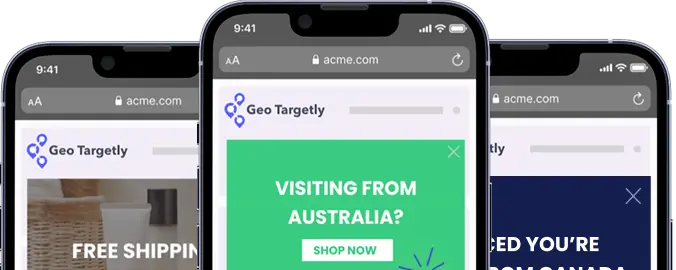

Key takeaways:
- Localization testing verifies the functionality, accuracy, and UX of every language and region variant of your site.
- It’s not the same as translation testing. You’re testing real-world experiences, not just words.
- Mistakes like currency mismatches or broken redirects are common, and they cost trust and conversions.
- You’ll need to test things like forms, layouts, content, metadata, and region-specific URLs.
- Dynamic tools like Geo Targetly let you simulate regional experiences without switching VPNs or staging dozens of versions
If your site serves more than one region or language, localization testing is essential to success. A flawless homepage in English means nothing if the French version is full of broken forms, untranslated buttons, and currency errors. Localization testing helps you catch those issues before your users do.
In this guide, we’ll break down how to test localized websites properly, from UX checks to SEO setup. You’ll get real examples, step-by-step workflows, tool comparisons, and tips for testing efficiently, especially if you’re managing 5, 10, or 50+ locales.
Want to simplify your localization QA?
Try Geo Targetly’s Geo Redirect feature to simulate and test region-specific site experiences from a single URL.
What is website localization testing?
Localization testing is the process of checking how well your website performs for users in different regions, languages, or cultures.
Unlike translation testing, which focuses purely on the accuracy of language, localization testing looks at the complete user experience, including content, layout, functionality, and even cultural context.
It also differs from internationalization testing, which checks whether your site can be easily adapted for different markets in the first place. Localization testing happens after that step, once the localized content and features are live.
At its core, localization testing asks a simple question: Does this version of the site feel correct, natural, and functional to someone in this region?
Why localization testing matters for multi-region websites
If you’re targeting users in different countries or languages, localization testing is not optional. A single broken redirect, untranslated word, or mismatched currency can cause confusion, break trust, or even drive people away.
Common localization failures
- A global e-commerce site shows US dollars to European visitors, leading to confusion at checkout
- Language switchers lead to the homepage instead of the current product page
- Promotional banners are still in English, even though the rest of the page is translated
- Arabic text is misaligned due to incorrect right-to-left formatting
These small issues add up. They can increase bounce rates, cart abandonment, and customer frustration, especially when they affect key user flows like checkout, sign-up, or contact forms.
The business impact
Localization issues aren’t just technical slipups; they have real consequences for how users interact with your site and whether they convert. A single mistranslation or currency error can make your brand seem untrustworthy or unprofessional in the eyes of local customers.
The numbers make it clear:
- 76% of users prefer to buy from websites in their native language, and more than 40% won’t even consider purchasing if their language isn’t supported.
- Localized websites can see up to 70% higher conversion rates in their target markets.
- And when it comes to marketing, 86% of localized campaigns outperform English-only ones in engagement and conversions.
That means sloppy website localization isn’t just a UX issue. It’s lost revenue, higher bounce rates, and weaker brand perception. Fixing these problems starts with proper testing.
In order to avoid mistranslation or currency errors, we recommend using Geo Targety's Geo Translate and Geo Currency features.
Key components of localization testing
.webp)
Localization testing goes far beyond checking translations or clicking through pages. The goal is to validate the full user experience in each locale.
That includes technical setup, visual layout, language accuracy, and cultural relevance. When testing a global site, here’s what you’re actually reviewing:
Functional accuracy: does everything still work?
Start with the basics. Are the forms submitting? Do the language switchers route users correctly? If your site redirects based on location, does that logic still hold up in every country variant?
Functional bugs are easy to overlook when you assume all versions behave the same. They often don’t.
Linguistic precision: are the words right?
This isn’t just about grammar. It’s about tone, intent, and placement. You’re checking whether translations are accurate in context, not just technically correct.
Look for placeholders that didn’t get swapped out, content that feels like a rough machine translation, or phrases that are awkward for the region.
UI and layout: does it still look clean?
Some languages expand dramatically in length. Others read right-to-left. This can break your design fast. Check if text is overflowing, buttons are misaligned, or your layout gets crushed on mobile in some versions.
It’s not enough for the content to be readable, it has to look good, too.
Format and data display: is it locally correct?
Date, time, currency, phone numbers, units of measurement. These need to reflect local norms. A price in USD on a French site or a mm/dd/yyyy date format on a German checkout page creates confusion.
It signals that you’re not really “local,” even if the rest of the site is.
Cultural relevance: are visuals and phrasing appropriate?
Images, icons, idioms, and even colors carry meaning. That cheeky image you use on your US homepage might seem off in Japan. Humor doesn’t always translate. Neither do holiday themes, pop culture references, or casual slang.
Localization testing means stepping outside your own cultural bubble.
SEO and technical localization: does search see it correctly?
Search engines need to understand your localized structure just as clearly as users do. This means checking your hreflang setup, verifying metadata in every language, and testing your localized URLs.
If you’re using a tool like Geo Targetly, this also includes confirming that dynamic URLs are routing properly per region or language.
How to conduct website localization testing (step-by-step process)
A well-structured localization QA process helps you catch critical errors before they go live. Whether you're running manual tests, automating parts of the flow, or managing multiple locales at once, the process needs to be clear and repeatable.
Step 1: Define your target locales
Start by identifying which regions and languages matter most. This usually aligns with your business priorities. Create a simple testing matrix that covers all key variants; for example, en-US, en-GB, fr-FR, de-DE.
Don’t forget to account for language differences within the same language group.
Step 2: Set up your test environment
Use a staging environment with region‑specific URLs. If you're using Geo Targetly’s Geo Redirect, you can simulate different user locations either through their built‑in location simulation tool or by configuring test links with region parameters.
This avoids the messiness of VPNs and lets you test multiple local versions side by side.
Step 3: Create test cases for each locale
Write out scenarios that reflect how users actually interact with the site. Think login flows, checkout processes, error messages, triggered emails, and form submissions. Use localized test data (names, addresses, currencies) to reflect each market accurately.
Step 4: Use localization testing tools
Manual testing is important, but automation speeds things up. Tools like BrowserStack, Lokalise QA, and Smartling can help.
Geo Targetly is useful here too, especially for testing how dynamic URLs perform across locations without needing a physical device or IP switch.
Step 5: Automate where it makes sense
Automated screenshot comparisons can catch layout issues like overlapping buttons or cut-off text. You can also use tools like Selenium or Cypress to run repeated checks across locales.
When paired with Geo Targetly’s dynamic URLs, this helps you validate how regional redirects behave in production.
Step 6: Review results and keep iterating
Log bugs by locale. Run regression tests after any update to your content or code. Localization QA is ongoing, not a one-time checklist. Make sure your process includes regular check-ins and re-tests.
Common localization testing challenges
Even with the right tools and workflows, localization testing can surface a lot of friction. These challenges are especially common in teams managing multiple locales or constantly releasing new content.
Unreliable location testing: Using VPNs to simulate user locations often fails due to caching, IP misidentification, or inconsistent behavior across devices. This makes it hard to replicate real user experiences by region.
Untranslated or hidden UI content: Strings hardcoded into templates or buried in conditional logic often get missed during translation. This leads to confusing user interfaces or fallback languages showing in the wrong markets.
RTL and multi-script display issues: Right-to-left languages like Arabic or Hebrew require specific layout support. If your CSS or templates are not built with RTL in mind, you’ll end up with broken interfaces or misaligned text.
Visual inconsistencies and text overflow: Localized strings are rarely the same length as their original versions. Without layout flexibility or automated visual checks, longer text can cause truncation, overlapping elements, or broken buttons.
Date, time, and currency format mismatches: Even simple things like “02/03/2025” can confuse users if the site doesn’t adapt to local date or currency conventions. These issues often slip through if test data is not localized.
Version drift between locales: It’s common for one language version to receive updates or bug fixes faster than others. This creates mismatches in messaging, content, or feature availability, which confuses global users.
SEO misconfigurations: Incorrect hreflang tags, missing alternate URLs, or improperly configured canonical links can tank localized SEO efforts. Many teams forget to test how search engines interpret their regional pages.
Automation gaps: Most automated QA setups are not designed to validate localized elements. Visual bugs, untranslated content, or layout issues often go undetected without human input or proper tooling.
How to measure localization testing success
You can’t improve what you don’t measure. Tracking localization QA helps teams prioritize issues, justify resource allocation, and prove the impact of their efforts across markets.
Metrics to track
Bug density by locale: How many issues are found per region or language version? A high number may signal systemic issues in the workflow, like inconsistent handoffs or poor translation memory coverage.
Post-release issue volume: Track the number of bugs reported by users after deployment. This helps gauge how effective your testing was and whether QA is catching the right kinds of issues.
Time to resolve localization bugs: How long does it take to fix locale-specific issues once found? Shorter resolution times reflect better tooling, clearer ownership, and more efficient feedback loops.
Conversion rates by locale: Measure how localization affects behavior. Are certain regions converting less despite high traffic? QA gaps might be part of the problem, from mistranslations to broken checkout flows.
Localization ROI: This includes metrics like cost per locale tested versus the uplift in traffic, engagement, or sales. It’s especially helpful when building a business case for investing in better tools or expanding to new markets.
QA reporting framework: Use a simple dashboard to keep localization QA visible. For each market or language version, track:
- Bugs found
- Bugs fixed
- Key UX or SEO issues
- Regression test status
- Conversion performance over time
Tools like Trello, Notion, or Airtable work well for small teams. For larger organizations, integrate QA reporting into your existing product or analytics dashboards.
Advanced strategies for localization QA
Once the basics are covered, it’s worth exploring how automation, continuous delivery, and smarter SEO testing can scale your efforts and catch issues faster.
Automation and AI in localization QA
AI and machine learning are making localization QA faster and more scalable, especially for large websites with dozens of locales.
How it helps:
- Language models can detect grammar errors, missing translations, or content out of context.
- Automated layout checks can catch truncation or broken alignment across screen sizes.
- AI-driven visual comparison tools can spot layout shifts between language variants.
What to watch out for:
- AI still misses nuance, idioms, or visual cultural cues that only a native speaker would catch.
- Over-reliance on automation can lead to blind spots in tone, brand voice, and UX.
Use AI to speed up surface-level checks, not replace human review entirely.
Continuous localization and CI/CD integration
In modern development workflows, content is deployed continuously. Localization testing has to keep up.
Here’s how teams build it into CI/CD pipelines:
- Trigger localization checks during staging builds.
- Use test automation tools like Cypress or Selenium to simulate user actions.
- Inject Geo Targetly’s dynamic URLs to route test users through localized experiences.
This allows real-time validation of region-specific content during every release cycle.
Testing for SEO and regional visibility
Localization isn’t just about UX, it also impacts how people find your site.
Make sure to:
- Validate hreflang tags for every locale. Use our free hreflang generator tool to save time.
- Check canonical tags and sitemap inclusion for regional versions.
- Ensure localized URLs are crawlable and consistent.
Geo Targetly helps here too. Its redirection engine can serve region-specific URLs that align with your SEO strategy, without relying on separate domains or VPNs.
Tools for website localization testing
The right tools can make or break your localization testing workflow. Depending on your goals, you might need browser testing platforms, translation management systems (TMS), or smart redirect tools for URL testing.
Here’s a comparison of popular options:
Each tool plays a different role:
- Use BrowserStack or Testlio for front-end and device testing.
- Use Lokalise or Smartling to manage translations and language QA.
- Use Geo Targetly to validate region-specific experiences, URLs, and redirects, especially useful for testing geolocation logic without needing VPNs.
Best practices and tips for website localization testing
Localization testing can get messy without the right strategy. These tips help teams stay efficient, accurate, and aligned across languages and regions:
- Involve native speakers as early as possible in your QA process.
- Don’t wait for final translations. Start testing structure and layout with placeholders.
- Use staging environments with dynamic URLs to simulate localized experiences without VPNs.
- Keep your UI flexible to accommodate text expansion, especially for German, Finnish, or right-to-left languages.
- Validate forms, CTAs, and error messages in every language and currency setting.
- Track metrics like bug density, conversion by locale, and time-to-fix to measure progress.
- Document everything – screenshots, bugs, and test cases – for future reference and regression testing.
- Automate repetitive layout and URL checks when possible, but always do manual reviews for context and nuance.
These habits lead to better outcomes across all your global properties.
How Geo Targetly simplifies localization testing
.webp)
Localization testing usually requires jumping through hoops: VPNs, regional proxies, or staging subdomains just to check if your content appears correctly in different locations. Geo Targetly simplifies this process with dynamic URLs and location-based redirection logic built for modern QA teams.
Here’s how it helps:
- You can simulate region-specific user journeys without switching IPs. Just append a region parameter or use a test link that triggers the appropriate redirect.
- QA teams can verify localized content, redirects, and user flows in multiple countries using one shared set of test URLs.
- You can create test links for 10+ regions and cycle through them instantly, removing the need for expensive VPN setups.
- Redirect logic can be applied at the country, state, or city level, giving you fine-grained control over what users see in different locales.
Start testing smarter. Use Geo Targetly to streamline localization QA with dynamic URLs and region-based redirect logic. No VPNs or workarounds required.
Conclusion
Localization testing makes sure your site works the way it should for every market. That includes layout, language, functionality, and cultural details that shape how users experience your brand. When done well, it builds trust, increases engagement, and helps your content feel natural in each region.





.webp)


































